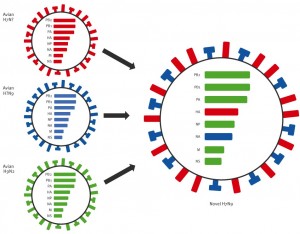 Hosts: Vincent Racaniello, Rich Condit, Dickson Despommier, and Alan Dove
Hosts: Vincent Racaniello, Rich Condit, Dickson Despommier, and Alan Dove
Vincent, Rich, Dickson, and Alan review the current status of human infections with avian influenza H7N9 virus.
Click arrow to play
Download TWiV 229 (69 MB .mp3, 95 min)
Subscribe (free): iTunes, RSS, email
Links for this episode:
- Hilary Koprowski, 96 (NY Times)
- Koprowski, Kessin, Racaniello photo
- Listen to the Music by Roger Vaughan
- Influenza ocular infections (one, two)
- H7N9 global concerns (NEJM)
- Human infection with H7N9 (NEJM)
- WHO Global Alert and Response, H7N9
- Avian influenza A(H7N9) virus (WHO)
- Novel H7N9 reassortant, implications for Europe (Eurosurveill)
- Genetic analysis of H7N9 (Eurosurveill)
- H7N9 compared with H7N7 outbreaks (Eurosurveill)
- Image credit: Eurosurveillance
- Letters read on TWiV 229
Weekly Science Picks
Alan – Nature PastCast
Rich – How dengue does it
Vincent – Squeaky Squeegee Art by Deb Sklut
Dickson – Agritecture
Listener Pick of the Week
Mike – Chemistry in its element: Elements and Compounds
Send your virology questions and comments (email or mp3 file) to [email protected]


http://traffic.libsyn.com/twiv/TWiV229.mp3
twiv229,recorded Apr.19,2013
17:30 first mention of H7N9
eye-infection of H7
21:40 mild undetected cases
(but they checked hundreds of contacts and didn’t find them)
23:00 adaptive mutations accumulate ?
(it also mutates and is selected in the host, trying to replicate
better, and in more cells)
30:00, infection,transmission 34:00 exists an example where a
virus mutated in a human to gain transmissiability
37:00 profvrr thinks it’s been in poultry for a while and did not
cause h2h, so it can’t
44:20 S1 and A1 very different –> 2 introductions
45:40 reassortment in avian host, they don’t know that
53:30 thinks the humans must have special genetics to be suspectible
55:20 AD thinks reassortment in swine is more likely
( http://www.flutrackers.com/forum/showthread.php?t=203696 , showing why H1N1 is critical)
57:00 many sporadic H7–> humans before (but H7s are different
and also the other segments, so you can’t really compare, no H7+H9N2 before)
1:00:00 3* don’t think this is a pandemic strain, again no probability estimates
but from the whole atmosphere I conclude that it’s dual use !)
1:08 emails
Seems that they only check cases based on signs and symptoms. No public data showing lab (PCR) testing of contacts. Which is an obvious sand big fail if so.
I hadn’t even thought about DURC when we had that discussion; but of course if you can spot a pandemic ‘genotype’ then it could be used. This is where the problems of DURC will rear their heads because it’s not the kind of information you want to hide. Fortunately we are not there yet.
it looks more and more to me that the main H7N9+H9N2 reassortment
happened early this year, that S1 is just strange, with mutations
acquired during prolonged disease or sequencing errors.
The same for Z2 in HA and maybe some others in NA.
We had such things before.
The remaining meanwhile 8 genomes with 3 excluded
subsequently reassorted segments and one partial HA
show a smooth picture of constantly evolving flu-A
since the initial reassortment ,probably in Jan.2013,
as we know it from other outbreaks.
that dating coincides with the Chinese new year poultry-movements
by humans and may even indicate the outbreak is human made,
nondeliberate, of course. Someone may have had a wild duck in his poultry cages.
Of course, it could also just have been wild birds droppings or such.
I love the idea of some 101 segments in the podcast. Also, I’m not like normal people 🙂 At home I have a 6000 rpm single speed centrifuge, an 1800x max magnification microscope, full lab glassware set, petri dishes with agar, etc. I’m a mad scientists. So all that to say that while I don’t have the advanced lab of a university or biotech facility, there are things I can do at home to help. It would be great to know what those things I can do are.
The PB2 E627K mutation is reflecting a shift in temperature optimum but it is the birds who have high body temperature, not the mammals.
So would a cell-line’s history be called a pedigree or a provenance?